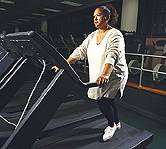
WEDNESDAY, May 15 (HealthDay News) — People who are obese or out of shape in their 40s or 50s might think it’s too late to start getting fit, but new research finds that shaping up in middle age lowers the odds for heart failure later in life.
What’s more, the reduction in risk is independent of other modifiable risk factors, such as smoking, high blood pressure and high cholesterol, the researchers said.
“It’s never too late to get fit,” said lead researcher Dr. Ambarish Pandey, an internal medicine resident at the University of Texas Southwestern Medical Center at Dallas.
“Fitness is a significant risk factor for heart failure,” Pandey said. “But if someone who is not fit in middle age improves his fitness over the years and gets in better shape, the risk of heart failure decreases.”
The results of the study are scheduled for presentation May 15 at an American Heart Association scientific meeting in Baltimore.
Heart failure — when the heart can’t pump enough blood to the rest of the body — is increasing as more people survive heart attacks and live longer with heart disease. More than 5 million Americans have the condition, and that number could increase 25 percent by 2030, according to the American Heart Association.
Heart failure is the most common reason older adults are hospitalized and rehospitalized, said American Heart Association spokesman Dr. Gregg Fonarow.
“One in five adults will develop heart failure in their lifetime, and 670,000 men and women in the United States will develop heart failure this year,” said Fonarow, director of the Cardiomyopathy Center at the David Geffen School of Medicine at the University of California, Los Angeles.
About half of people who develop heart failure die within five years of diagnosis, according to the U.S. Centers for Disease Control and Prevention.
“Yet in many cases, heart failure is preventable by maintaining cardiovascular health and control of heart failure risk factors,” Fonarow said. “These new findings suggest that improving cardiovascular fitness levels may be an effective way of lowering heart failure.”
For the study, Pandey’s team assessed fitness levels of more than 9,000 middle-aged men and women with an average age of 48 who were tested twice, eight years apart.
After 18 years of follow-up, the researchers matched the results with Medicare claims for heart failure hospitalizations.
They found that people who weren’t physically fit at the start of the study had a higher risk of heart failure after age 65. But those whose fitness improved on the tests had a lower risk of heart failure later on than those whose fitness remained poor.
Using a treadmill test to measure what are called “metabolic equivalents,” the researchers found the risk for heart failure dropped 20 percent for each improvement in metabolic equivalents.
If a 40-year-old improved from jogging a 12-minute mile to a 10-minute mile, an increase of two metabolic equivalents, the risk for heart failure would have dropped 40 percent, Pandey said.
Data and conclusions presented at meetings should be considered preliminary until published in a peer-reviewed medical journal.
More information
For more information on heart failure, visit the American Heart Association.

